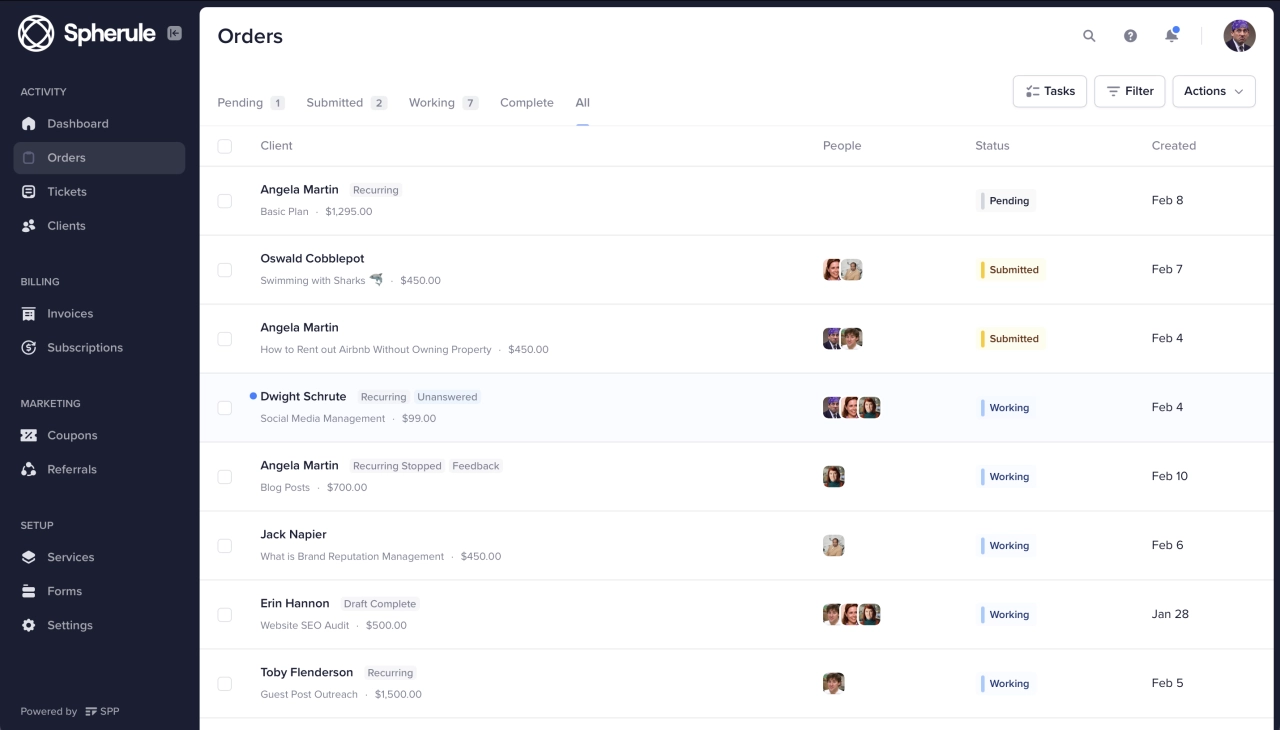Growth Calculator for Agencies
Simulate different growth scenarios for your agency and visualize the impact of customer acquisition, churn, and pricing on your MRR.
Growth Projections
Scenario 1
Scenario 2
Growth Analysis
Projected MRR Comparison
--%
Key Insights
- Small improvements in churn rate can make a substantial impact on MRR growth over time.
- Increasing new customers per month creates a compounding effect on revenue growth.
- Balance acquisition and retention strategies for optimal growth outcomes.
Recommended Actions
- Implement customer success programs to reduce churn.
- Optimize acquisition channels to increase new customer rate.
- Consider pricing adjustments to increase MRR per customer.
Frequently Asked Questions
- What is this calculator for?
-
This calculator helps marketing agencies visualize and compare different growth scenarios based on customer acquisition, retention, and pricing strategies. It projects how your monthly recurring revenue (MRR) will change over time based on key business metrics.
You can use it to:
- Forecast your agency's revenue growth over the next 32 months
- Compare the impact of different business strategies side-by-side
- Understand which growth levers (acquisition, retention, pricing) have the biggest impact
- Set realistic growth targets based on data-driven projections
- Demonstrate the value of strategic changes to your team or stakeholders
- What do the different inputs mean?
-
The calculator uses four key inputs for each growth scenario:
- Current Customers: Your starting customer base at the beginning of the projection period.
- New Customers Per Month: How many new clients you acquire each month (customer acquisition rate).
- Monthly Churn Rate: The percentage of existing customers who leave or cancel each month.
- MRR Per Customer: The average monthly recurring revenue you earn from each customer.
These four metrics represent the fundamental drivers of recurring revenue growth for any subscription-based business model.
- How are the calculations performed?
-
For each month in the 32-month projection period, the calculator:
- Calculates customer churn by multiplying your current customer count by the monthly churn rate percentage
- Updates your customer count by adding new customers and subtracting those who churned
- Calculates MRR by multiplying the updated customer count by the MRR per customer
- Plots the MRR value for that month on the line graph
This iterative process continues for all 32 months to show the compounding effects of your growth factors over time. The formula can be expressed as:
Customers(n) = Customers(n-1) + NewCustomers - (Customers(n-1) × ChurnRate)
MRR(n) = Customers(n) × MRRPerCustomer
Where n is the current month and n-1 is the previous month.
- Why compare two scenarios?
-
Comparing two scenarios allows you to:
- Evaluate different business strategies side-by-side
- Understand the impact of specific changes to your growth metrics
- Make data-driven decisions about where to focus your improvement efforts
- Identify which growth levers (acquisition, retention, or pricing) give you the biggest return
- Set realistic goals by comparing your current trajectory with an aspirational one
- Build business cases for investments in specific areas
For example, you can compare your current growth path with a potential future state where you've improved customer retention or increased your acquisition rate. This comparison helps quantify the value of strategic initiatives.
- What insights can I gain from this calculator?
-
This calculator demonstrates how small differences in growth factors can dramatically impact your agency's revenue over time. Key insights include:
- The compounding effect of improved customer retention (lower churn)
- How increasing customer acquisition affects long-term growth
- The impact of different pricing strategies on your revenue trajectory
- The relationship between acquisition, retention, and revenue growth
- The "hockey stick" growth potential when multiple factors improve together
- The financial impact of seemingly small improvements in key metrics
The default values show how Scenario 2 (more new customers and lower churn) outperforms Scenario 1 over time, highlighting the importance of both customer acquisition and retention for sustainable agency growth trajectory .
- How can I improve my agency's growth metrics?
-
Based on the calculator's insights, here are strategies to improve each growth metric:
-
Reduce Churn Rate:
- Implement proactive customer success programs
- Establish regular check-ins and performance reviews
- Create loyalty programs for long-term customers
- Collect and act on customer feedback
- Implement early warning systems to identify at-risk clients
- Maintain consistent quality and communication standards
- Establish clear scope boundaries and expectations
-
Increase New Customers:
- Invest in content marketing and thought leadership
- Optimize marketing channels and lead generation
- Implement referral programs with incentives
- Improve sales processes and conversion rates
- Develop strategic partnerships and co-marketing opportunities
- Expand service offerings to new markets
- Create case studies and social proof materials
-
Increase MRR Per Customer:
- Develop upsell and cross-sell opportunities
- Create premium service tiers
- Bundle complementary services
- Implement value-based pricing
- Add recurring service components to project work
- Increase rates for new clients gradually
- Develop specialized high-value service offerings
-
- Why does churn have such a big impact on growth?
-
Churn has a multiplier effect on your growth trajectory for several reasons:
- As your customer base grows, the same churn percentage represents more lost customers
- Lost customers represent both immediate revenue loss and lost future revenue potential
- Acquiring new customers typically costs 5-25x more than retaining existing ones
- High churn can offset or completely negate strong customer acquisition efforts
- Churn compounds over time, creating an increasingly difficult growth hurdle
- Retained customers often increase in value over time (expansion revenue)
This is why reducing churn by even 1-2 percentage points can have a dramatic compounding effect on your long-term growth projections. Try adjusting just the churn rates in the calculator to see this effect.
- How do I determine appropriate input values for my agency?
-
To set realistic values for your agency:
- Current Customers: Use your actual current client count with active retainers or recurring contracts.
- New Customers Per Month: Review your past 6-12 months of new client acquisition data to find your monthly average. For smaller agencies, you might want to use a quarterly average divided by three.
- Monthly Churn Rate: Calculate this by dividing the number of customers who canceled in recent months by your total customers at the start of those months. Multiply by 100 to get a percentage. Industry benchmarks for agencies are typically 3-7% monthly churn.
- MRR Per Customer: Divide your total recurring revenue by your total number of customers. For project-based agencies transitioning to retainers, use your target or average retainer value.
Remember that these are averages, and your actual results may vary month to month. Using a 6-12 month historical average provides more stable projections.
- What are healthy growth benchmarks for agencies?
-
Industry benchmarks vary by agency size , maturity, and specialization, but general guidelines include:
-
Monthly Churn Rate:
- Excellent: <3%
- Good: 3-5%
- Average: 5-7%
- Concerning: >7%
-
New Customer Growth Rate:
- Startup agencies: 10-15% monthly customer growth
- Established agencies: 5-10% monthly customer growth
- Mature agencies: 2-5% monthly customer growth
-
MRR Growth Rate:
- Excellent: >15% year-over-year
- Good: 10-15% year-over-year
- Average: 5-10% year-over-year
Use these benchmarks as reference points, but remember that your agency's specific circumstances will affect what's realistic and attainable for your business.
-
Monthly Churn Rate:
- What limitations should I be aware of when using this calculator?
-
While this calculator is powerful, it has some simplifications you should be aware of:
- It assumes consistent monthly performance across all input variables, while real-world performance often fluctuates seasonally
- It doesn't account for customer expansion revenue (increasing MRR from existing customers over time)
- It doesn't factor in the costs associated with customer acquisition or retention efforts
- It uses a linear growth model for new customers, rather than accounting for potential acceleration as your marketing improves
- It doesn't differentiate between types of customers or service tiers
- It doesn't account for changes to your business model or service offerings over time
Use this calculator for strategic planning and directional guidance rather than precise financial forecasting. It's designed to illustrate the relationship between key growth drivers, not to replace detailed financial modeling.
- How do I balance customer acquisition with retention efforts?
-
Finding the right balance between acquisition and retention depends on your agency's growth stage and goals:
- New agencies (0-2 years): Focus 70% on acquisition, 30% on retention. Prioritize building a client base while establishing retention processes.
- Growing agencies (2-5 years): Balance with 50% acquisition, 50% retention. Begin optimizing retention systems while maintaining steady growth.
- Established agencies (5+ years): Shift to 40% acquisition, 60% retention. Prioritize client longevity and expansion revenue while maintaining moderate new client growth.
Use the calculator to simulate different balances by adjusting new customer acquisition rates and churn rates. The optimal balance is one that maximizes your long-term MRR while maintaining sustainable operations.
Also consider that improved retention creates a more stable foundation for acquisition efforts, as you're not constantly replacing churned customers just to maintain your size.
- How can this calculator help with setting realistic growth targets?
-
This calculator helps set data-driven growth targets by:
- Showing the mathematical relationship between your inputs and outcomes
- Revealing which metrics have the biggest impact on your growth trajectory
- Demonstrating the compounding effects of improvements over time
- Providing a framework for "what-if" analyses with different scenarios
- Showing when specific revenue milestones will be reached under different conditions
To set realistic targets:
- Start with your current metrics as Scenario 1
- Create Scenario 2 with realistic improvements to one or two metrics
- Observe the projected difference over 32 months
- Set milestone targets at 3, 6, 12, and 24 months based on the projection
- Revisit and adjust quarterly as you gather actual performance data
Use these projections for strategic prioritization , focusing resources on the metrics that will drive the most significant growth for your agency.

You're in good company. We've helped agencies like yours sell $500M+ in services.


